Note
Click here to download the full example code
Compares implementations of ReduceMax#
This example compares the numpy for the operator ReduceMax to onnxruntime implementation. If available, tensorflow and pytorch are included as well.
Available optimisation#
The code shows which parallelisation optimisation could be used, AVX or SSE and the number of available processors.
import numpy
import pandas
import matplotlib.pyplot as plt
from onnxruntime import InferenceSession
from skl2onnx.common.data_types import FloatTensorType
from skl2onnx.algebra.onnx_ops import OnnxReduceMax
from cpyquickhelper.numbers import measure_time
from tqdm import tqdm
from mlprodict.testing.experimental_c_impl.experimental_c import code_optimisation
print(code_optimisation())
Out:
AVX-omp=8
ReduceMax implementations#
try:
from tensorflow.math import reduce_max as tf_reduce_max
from tensorflow import convert_to_tensor
except ImportError:
tf_reduce_max = None
try:
from torch import max as torch_max, from_numpy
except ImportError:
torch_max = None
def build_ort_reducemax(axes, op_version=14): # opset=13, 14, ...
node = OnnxReduceMax('x', axes=axes, op_version=op_version,
output_names=['z'])
onx = node.to_onnx(inputs=[('x', FloatTensorType())],
target_opset=op_version)
sess = InferenceSession(onx.SerializeToString())
return lambda x, y: sess.run(None, {'x': x})
def loop_fct(fct, xs, ys):
for x, y in zip(xs, ys):
fct(x, y)
def benchmark_op(axes, repeat=2, number=5, name="ReduceMax", shape_fct=None):
if shape_fct is None:
def shape_fct(dim):
return (3, dim, 1, 128, 64)
ort_fct = build_ort_reducemax(axes)
res = []
for dim in tqdm([8, 16, 32, 64, 100, 128, 200,
256, 400, 512, 1024]):
shape = shape_fct(dim)
n_arrays = 10 if dim < 512 else 4
xs = [numpy.random.rand(*shape).astype(numpy.float32)
for _ in range(n_arrays)]
ys = [numpy.array(axes, dtype=numpy.int64)
for _ in range(n_arrays)]
info = dict(axes=axes, shape=shape)
# numpy
ctx = dict(
xs=xs, ys=ys,
fct=lambda x, y: numpy.amax(x, tuple(y)),
loop_fct=loop_fct)
obs = measure_time(
"loop_fct(fct, xs, ys)",
div_by_number=True, context=ctx, repeat=repeat, number=number)
obs['dim'] = dim
obs['fct'] = 'numpy'
obs.update(info)
res.append(obs)
# onnxruntime
ctx['fct'] = ort_fct
obs = measure_time(
"loop_fct(fct, xs, ys)",
div_by_number=True, context=ctx, repeat=repeat, number=number)
obs['dim'] = dim
obs['fct'] = 'ort'
obs.update(info)
res.append(obs)
if tf_reduce_max is not None:
# tensorflow
ctx['fct'] = tf_reduce_max
ctx['xs'] = [convert_to_tensor(x) for x in xs]
ctx['ys'] = ys
obs = measure_time(
"loop_fct(fct, xs, ys)",
div_by_number=True, context=ctx, repeat=repeat, number=number)
obs['dim'] = dim
obs['fct'] = 'tf'
obs.update(info)
res.append(obs)
if torch_max is not None:
def torch_max1(x, y):
return torch_max(x, y[0])
def torch_max2(x, y):
return torch_max(torch_max(x, y[1])[0], y[0])[0]
# torch
ctx['fct'] = torch_max1 if len(axes) == 1 else torch_max2
ctx['xs'] = [from_numpy(x) for x in xs]
ctx['ys'] = ys # [from_numpy(y) for y in ys]
obs = measure_time(
"loop_fct(fct, xs, ys)",
div_by_number=True, context=ctx, repeat=repeat, number=number)
obs['dim'] = dim
obs['fct'] = 'torch'
obs.update(info)
res.append(obs)
# Dataframes
shape_name = str(shape).replace(str(dim), "N")
df = pandas.DataFrame(res)
df.columns = [_.replace('dim', 'N') for _ in df.columns]
piv = df.pivot('N', 'fct', 'average')
rs = piv.copy()
for c in ['ort', 'torch', 'tf', 'tf_copy']:
if c in rs.columns:
rs[c] = rs['numpy'] / rs[c]
rs['numpy'] = 1.
# Graphs.
fig, ax = plt.subplots(1, 2, figsize=(12, 4))
piv.plot(logx=True, logy=True, ax=ax[0],
title="%s benchmark\n%r - %r"
" lower better" % (name, shape_name, axes))
ax[0].legend(prop={"size": 9})
rs.plot(logx=True, logy=True, ax=ax[1],
title="%s Speedup, baseline=numpy\n%r - %r"
" higher better" % (name, shape_name, axes))
ax[1].plot([min(rs.index), max(rs.index)], [0.5, 0.5], 'g--')
ax[1].plot([min(rs.index), max(rs.index)], [2., 2.], 'g--')
ax[1].legend(prop={"size": 9})
return df, rs, ax
dfs = []
Reduction on a particular case KR#
Consecutive axis not reduced and consecutive reduced axis are merged. KR means kept axis - reduced axis
(8, 24, 48, N), axis=(3, )#
axes = (3, )
df, piv, ax = benchmark_op(axes, shape_fct=lambda dim: (8, 24, 48, dim))
dfs.append(df)
df.pivot("fct", "N", "average")
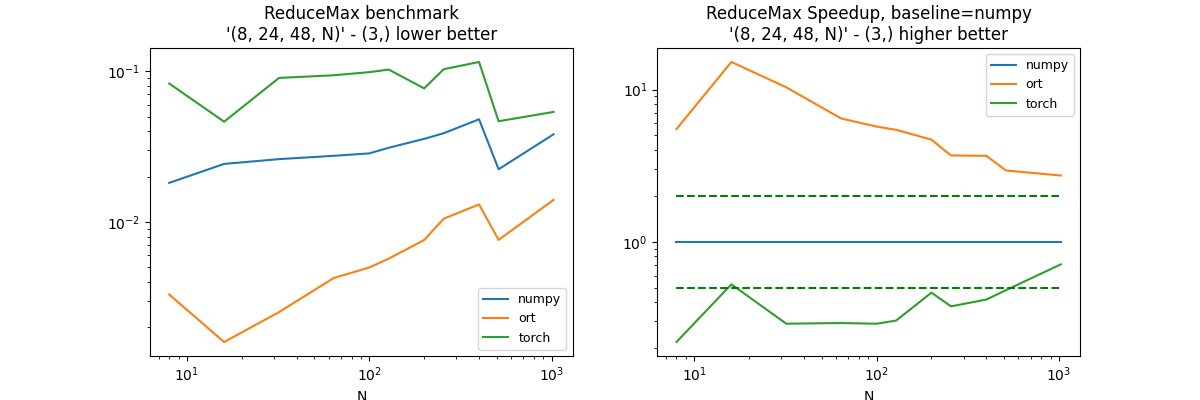
Out:
0%| | 0/11 [00:00<?, ?it/s]
9%|9 | 1/11 [00:01<00:10, 1.09s/it]
18%|#8 | 2/11 [00:01<00:08, 1.11it/s]
27%|##7 | 3/11 [00:03<00:08, 1.08s/it]
36%|###6 | 4/11 [00:04<00:08, 1.23s/it]
45%|####5 | 5/11 [00:06<00:08, 1.37s/it]
55%|#####4 | 6/11 [00:08<00:07, 1.51s/it]
64%|######3 | 7/11 [00:09<00:06, 1.61s/it]
73%|#######2 | 8/11 [00:12<00:05, 1.83s/it]
82%|########1 | 9/11 [00:15<00:04, 2.18s/it]
91%|######### | 10/11 [00:16<00:01, 1.94s/it]
100%|##########| 11/11 [00:18<00:00, 2.05s/it]
100%|##########| 11/11 [00:18<00:00, 1.71s/it]
Reduction on a particular case RK#
Consecutive axis not reduced and consecutive reduced axis are merged. RK means reduced axis - kept axis,
(8, 24, 48, N), axis=(0, )#
axes = (0, )
df, piv, ax = benchmark_op(axes, shape_fct=lambda dim: (8, 24, 48, dim))
dfs.append(df)
df.pivot("fct", "N", "average")
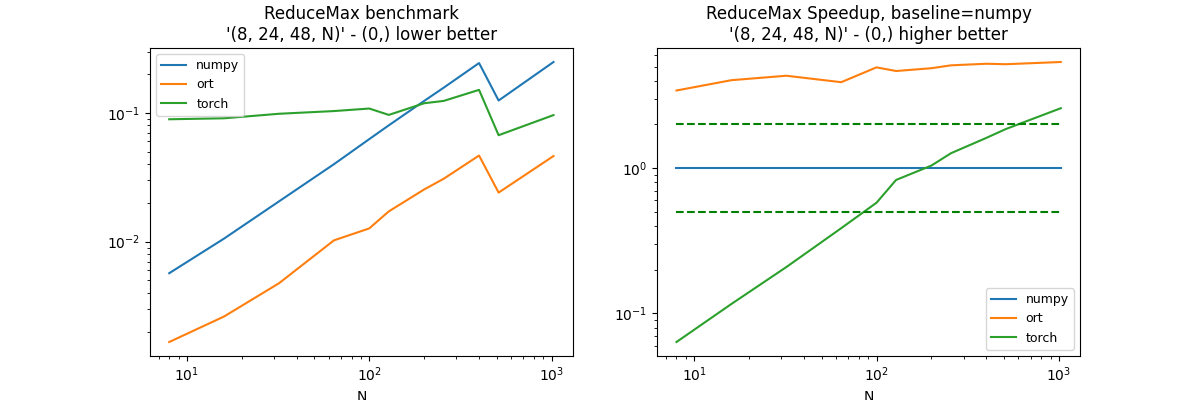
Out:
0%| | 0/11 [00:00<?, ?it/s]
9%|9 | 1/11 [00:00<00:09, 1.01it/s]
18%|#8 | 2/11 [00:02<00:09, 1.05s/it]
27%|##7 | 3/11 [00:03<00:09, 1.18s/it]
36%|###6 | 4/11 [00:05<00:09, 1.40s/it]
45%|####5 | 5/11 [00:07<00:10, 1.67s/it]
55%|#####4 | 6/11 [00:09<00:09, 1.89s/it]
64%|######3 | 7/11 [00:12<00:09, 2.35s/it]
73%|#######2 | 8/11 [00:16<00:08, 2.84s/it]
82%|########1 | 9/11 [00:22<00:07, 3.71s/it]
91%|######### | 10/11 [00:25<00:03, 3.42s/it]
100%|##########| 11/11 [00:30<00:00, 3.95s/it]
100%|##########| 11/11 [00:30<00:00, 2.76s/it]
Reduction on a particular case KRK#
Consecutive axis not reduced and consecutive reduced axis are merged. KRK means kept axis - reduced axis - kept axis,
(8, 24, 48, N), axis=(1, 2)#
axes = (1, 2)
df, piv, ax = benchmark_op(axes, shape_fct=lambda dim: (8, 24, 48, dim))
dfs.append(df)
df.pivot("fct", "N", "average")
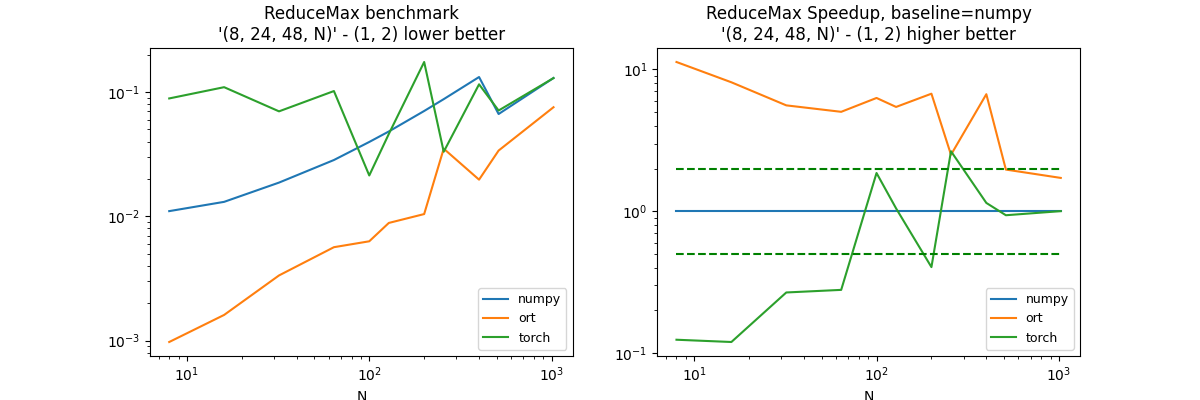
Out:
0%| | 0/11 [00:00<?, ?it/s]
9%|9 | 1/11 [00:01<00:10, 1.04s/it]
18%|#8 | 2/11 [00:02<00:10, 1.19s/it]
27%|##7 | 3/11 [00:03<00:08, 1.11s/it]
36%|###6 | 4/11 [00:04<00:09, 1.29s/it]
45%|####5 | 5/11 [00:05<00:07, 1.18s/it]
55%|#####4 | 6/11 [00:07<00:06, 1.26s/it]
64%|######3 | 7/11 [00:10<00:07, 1.88s/it]
73%|#######2 | 8/11 [00:12<00:06, 2.03s/it]
82%|########1 | 9/11 [00:16<00:05, 2.61s/it]
91%|######### | 10/11 [00:19<00:02, 2.52s/it]
100%|##########| 11/11 [00:23<00:00, 3.15s/it]
100%|##########| 11/11 [00:23<00:00, 2.15s/it]
(8, 24 * 48, N), axis=1#
axes = (1, )
df, piv, ax = benchmark_op(axes, shape_fct=lambda dim: (8, 24 * 48, dim))
dfs.append(df)
df.pivot("fct", "N", "average")
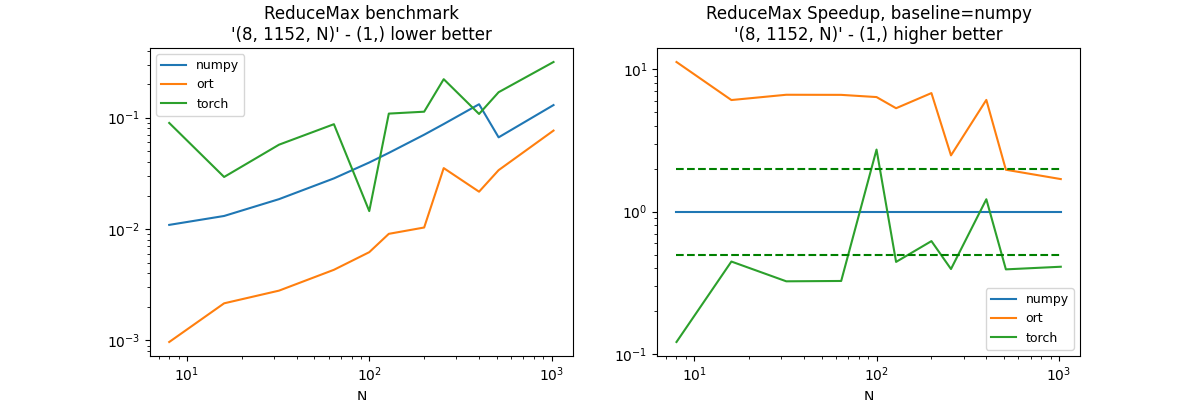
Out:
0%| | 0/11 [00:00<?, ?it/s]
9%|9 | 1/11 [00:01<00:10, 1.05s/it]
18%|#8 | 2/11 [00:01<00:06, 1.38it/s]
27%|##7 | 3/11 [00:02<00:06, 1.25it/s]
36%|###6 | 4/11 [00:03<00:07, 1.04s/it]
45%|####5 | 5/11 [00:04<00:05, 1.01it/s]
55%|#####4 | 6/11 [00:06<00:06, 1.35s/it]
64%|######3 | 7/11 [00:09<00:06, 1.74s/it]
73%|#######2 | 8/11 [00:13<00:07, 2.53s/it]
82%|########1 | 9/11 [00:17<00:05, 2.93s/it]
91%|######### | 10/11 [00:20<00:03, 3.05s/it]
100%|##########| 11/11 [00:27<00:00, 4.09s/it]
100%|##########| 11/11 [00:27<00:00, 2.47s/it]
(2, 8, 12, 24, 2, N), axis=(2, 3)#
axes = (2, 3)
df, piv, ax = benchmark_op(axes, shape_fct=lambda dim: (2, 8, 12, 24, 2, dim))
dfs.append(df)
df.pivot("fct", "N", "average")
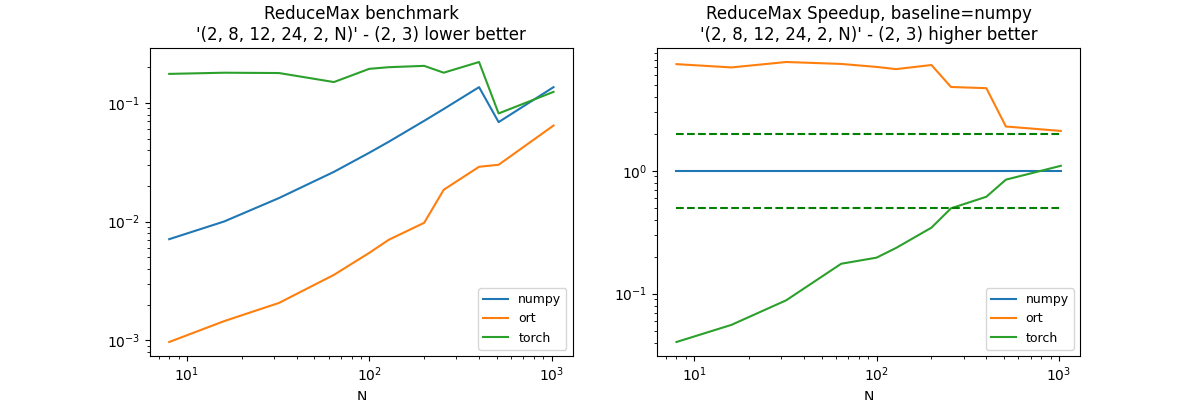
Out:
0%| | 0/11 [00:00<?, ?it/s]
9%|9 | 1/11 [00:01<00:18, 1.87s/it]
18%|#8 | 2/11 [00:03<00:17, 1.93s/it]
27%|##7 | 3/11 [00:05<00:15, 1.99s/it]
36%|###6 | 4/11 [00:07<00:13, 2.00s/it]
45%|####5 | 5/11 [00:10<00:13, 2.24s/it]
55%|#####4 | 6/11 [00:13<00:12, 2.48s/it]
64%|######3 | 7/11 [00:16<00:11, 2.80s/it]
73%|#######2 | 8/11 [00:20<00:09, 3.07s/it]
82%|########1 | 9/11 [00:25<00:07, 3.70s/it]
91%|######### | 10/11 [00:28<00:03, 3.31s/it]
100%|##########| 11/11 [00:32<00:00, 3.67s/it]
100%|##########| 11/11 [00:32<00:00, 2.97s/it]
Reduction on a particular case RKR#
(N, 64, 16, 16), axis=(0, 2, 3)#
axes = (0, 2, 3)
df, piv, ax = benchmark_op(
axes, shape_fct=lambda dim: (dim, 64, 16, 16))
dfs.append(df)
df.pivot("fct", "N", "average")
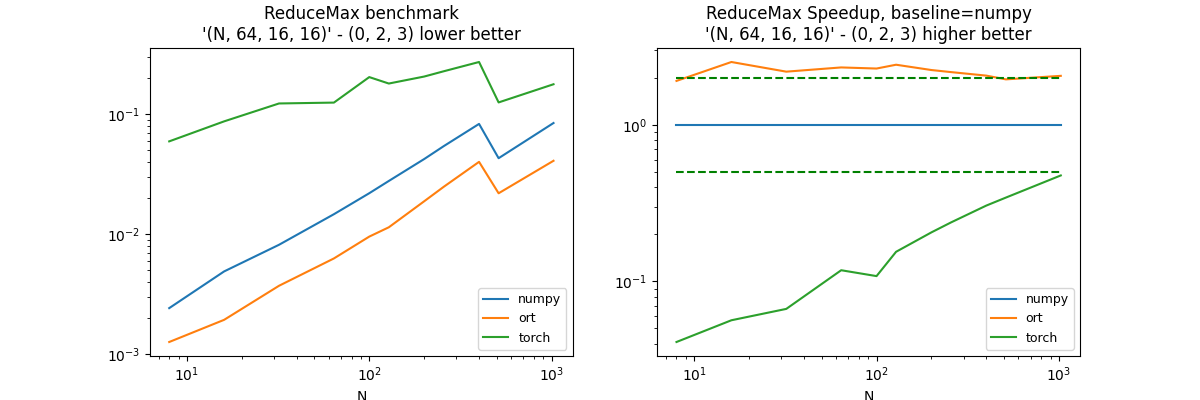
Out:
0%| | 0/11 [00:00<?, ?it/s]
9%|9 | 1/11 [00:00<00:06, 1.48it/s]
18%|#8 | 2/11 [00:01<00:07, 1.13it/s]
27%|##7 | 3/11 [00:03<00:09, 1.18s/it]
36%|###6 | 4/11 [00:05<00:09, 1.42s/it]
45%|####5 | 5/11 [00:07<00:11, 1.95s/it]
55%|#####4 | 6/11 [00:10<00:11, 2.27s/it]
64%|######3 | 7/11 [00:14<00:10, 2.75s/it]
73%|#######2 | 8/11 [00:18<00:09, 3.28s/it]
82%|########1 | 9/11 [00:25<00:08, 4.16s/it]
91%|######### | 10/11 [00:28<00:03, 3.80s/it]
100%|##########| 11/11 [00:33<00:00, 4.23s/it]
100%|##########| 11/11 [00:33<00:00, 3.02s/it]
Reduction on a particular case RKRK#
(8, 24, 48, N), axis=(0, 2)#
axes = (0, 2)
df, piv, ax = benchmark_op(axes, shape_fct=lambda dim: (8, 24, 48, dim))
dfs.append(df)
df.pivot("fct", "N", "average")
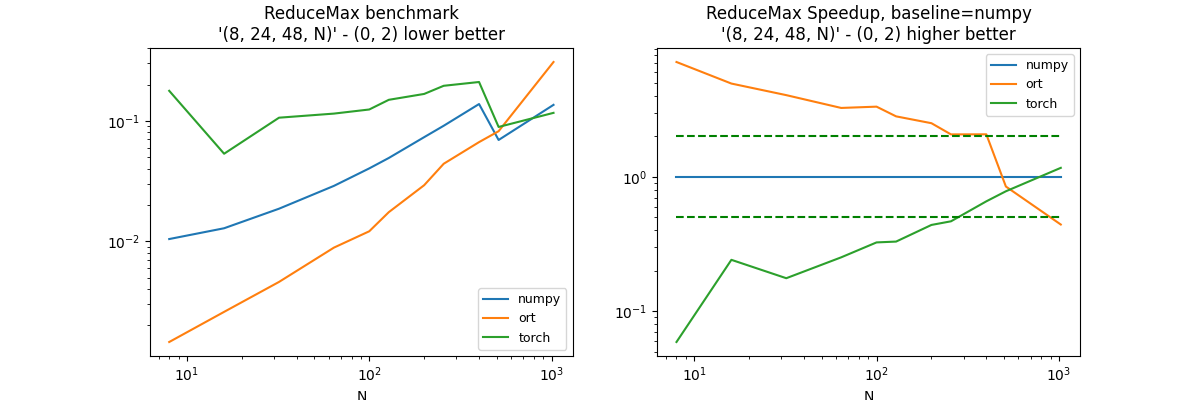
Out:
0%| | 0/11 [00:00<?, ?it/s]
9%|9 | 1/11 [00:01<00:19, 1.92s/it]
18%|#8 | 2/11 [00:02<00:11, 1.23s/it]
27%|##7 | 3/11 [00:04<00:10, 1.31s/it]
36%|###6 | 4/11 [00:05<00:10, 1.47s/it]
45%|####5 | 5/11 [00:07<00:10, 1.69s/it]
55%|#####4 | 6/11 [00:10<00:09, 1.98s/it]
64%|######3 | 7/11 [00:13<00:09, 2.41s/it]
73%|#######2 | 8/11 [00:17<00:08, 2.94s/it]
82%|########1 | 9/11 [00:23<00:07, 3.69s/it]
91%|######### | 10/11 [00:26<00:03, 3.49s/it]
100%|##########| 11/11 [00:32<00:00, 4.51s/it]
100%|##########| 11/11 [00:32<00:00, 3.00s/it]
Conclusion#
Some of the configurations should be investigated. l-reducesum-problem1. The reduction on tensorflow in one dimension seems to be lazy.
merged = pandas.concat(dfs)
name = "reducemax"
merged.to_csv("plot_%s.csv" % name, index=False)
merged.to_excel("plot_%s.xlsx" % name, index=False)
plt.savefig("plot_%s.png" % name)
plt.show()

Total running time of the script: ( 3 minutes 36.816 seconds)